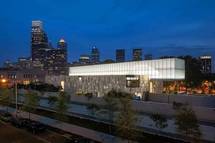
The $25-billion collection, hailed as one of the greatest art collections in the world, features more Cezannes than there are in Paris. There is Henri Matisse's largest work, numerous masterpieces by Picasso, and 181 Renoirs.
Even now there is not full agreement, however, with supporters heralding a new era and some detractors worrying that improvements came at the cost of the original museum's soul.
"The Barnes today is more stable and more secure," insisted Joseph Neubauer, the vice-chairman of the foundation's board of trustees. "The pictures have never had a better home."
In addition to the impressive number of post-Impressionist and early-modern works, the Barnes also houses a significant amount of works by African-American and Native American artists.
But the real charm of the collection has always been in the iconoclastic manner in which the art was hung, the paintings arranged with total disregard to traditional notions of art history or theory.
So one Picasso was placed between unframed religious works by 19th Century painters in New Mexico. In another room, the paintings appeared in a cross comprised of works by 13th century Italian masters and unnamed Chinese artists.
This made for a unique experience for art lovers.
The foundation was also long-famously difficult to visit, with waiting lists often spanning months. Barnes himself famously turned down requests to see the collection.
The new building, while keeping the quirky layout, will help resolve that.
Entrance to the museum is sold out for the first ten days. But the new building will allow 225,000 visitors each year, compared to a previous maximum audience of 62,000.
While advance reservations are recommended, they may not be necessary.
"We always intend to keep a few tickets back for walk-ins," said Andrew Stewart, a spokesman for the foundation. "We were never able to do that in the old location."
The move comes with attempts to fix the foundation's finances, which were in dire straits by the 1990s.
Not everyone welcomed this. The foundation's wealthy neighbors feared increased traffic, while the plan to move the collection caused huge bitterness.
Opponents saw an attempt to betray Barnes' legacy and use it to bring more tourists to Philadelphia.
"This was a gift by a man who was a total visionary art collector," Evelyn Yaari, an opponent of the move told AFP last year. "If you move it downtown, it is not that gift."
Already tourism officials have launched a $2 million ad campaign to position the city as a major destination. They have dubbed the parkway the Foundation sits on the "Museum Mile" highlighting its proximity to The Philadelphia Museum of Art and the Rodin Museum.
Proponents of the move -- members of Philadelphia's business elite -- saw it as a way to save the collection and keep it independent. The board decided to move all the way back in 2002.
"In many ways, it was a lonely decision for us to make," said Stephen Harmelin, treasurer for the foundation.
The fight attracted the attention of the nation's largest newspapers. Critics weighed in from as far away as Los Angeles and the spat is documented in the award-winning film "The Art of the Steal," which galvanized much of the opposition.
With the opening of the new building, the battle over the move is largely over, if not forgotten. Minor points still play themselves out in court and at a media preview on Wednesday a handful of protesters stood outside.
Each gallery in the new building is a nearly exact replica of those at the former building, located about five miles away in a leafy Philadelphia suburb, and most visitors will have a hard time telling the difference.
Replicating the galleries was done to placate opponents and to satisfy the requirements of Barnes' will, which stated "all paintings shall remain in exactly the places they are at the time of the death of (Barnes)."
What's changed is that those galleries are housed in a building nearly eight times the size. Classrooms or gardens sit between the galleries.
"I think we've made a serene container for an amazing collection," said Billie Tsien, an architect on the project. While the old building relied on shades to block natural light and prevent damage to paintings, the new building gets more natural light. That visible difference has led many art aficionados to mistakenly believe the paintings have been cleaned.
"You can see the paintings in a light that gives more life to them," Tsien said.
--------------------------------------------------------------------------------------------
Even now there is not full agreement, however, with supporters heralding a new era and some detractors worrying that improvements came at the cost of the original museum's soul.
"The Barnes today is more stable and more secure," insisted Joseph Neubauer, the vice-chairman of the foundation's board of trustees. "The pictures have never had a better home."
In addition to the impressive number of post-Impressionist and early-modern works, the Barnes also houses a significant amount of works by African-American and Native American artists.
But the real charm of the collection has always been in the iconoclastic manner in which the art was hung, the paintings arranged with total disregard to traditional notions of art history or theory.
So one Picasso was placed between unframed religious works by 19th Century painters in New Mexico. In another room, the paintings appeared in a cross comprised of works by 13th century Italian masters and unnamed Chinese artists.
This made for a unique experience for art lovers.
The foundation was also long-famously difficult to visit, with waiting lists often spanning months. Barnes himself famously turned down requests to see the collection.
The new building, while keeping the quirky layout, will help resolve that.
Entrance to the museum is sold out for the first ten days. But the new building will allow 225,000 visitors each year, compared to a previous maximum audience of 62,000.
While advance reservations are recommended, they may not be necessary.
"We always intend to keep a few tickets back for walk-ins," said Andrew Stewart, a spokesman for the foundation. "We were never able to do that in the old location."
The move comes with attempts to fix the foundation's finances, which were in dire straits by the 1990s.
Not everyone welcomed this. The foundation's wealthy neighbors feared increased traffic, while the plan to move the collection caused huge bitterness.
Opponents saw an attempt to betray Barnes' legacy and use it to bring more tourists to Philadelphia.
"This was a gift by a man who was a total visionary art collector," Evelyn Yaari, an opponent of the move told AFP last year. "If you move it downtown, it is not that gift."
Already tourism officials have launched a $2 million ad campaign to position the city as a major destination. They have dubbed the parkway the Foundation sits on the "Museum Mile" highlighting its proximity to The Philadelphia Museum of Art and the Rodin Museum.
Proponents of the move -- members of Philadelphia's business elite -- saw it as a way to save the collection and keep it independent. The board decided to move all the way back in 2002.
"In many ways, it was a lonely decision for us to make," said Stephen Harmelin, treasurer for the foundation.
The fight attracted the attention of the nation's largest newspapers. Critics weighed in from as far away as Los Angeles and the spat is documented in the award-winning film "The Art of the Steal," which galvanized much of the opposition.
With the opening of the new building, the battle over the move is largely over, if not forgotten. Minor points still play themselves out in court and at a media preview on Wednesday a handful of protesters stood outside.
Each gallery in the new building is a nearly exact replica of those at the former building, located about five miles away in a leafy Philadelphia suburb, and most visitors will have a hard time telling the difference.
Replicating the galleries was done to placate opponents and to satisfy the requirements of Barnes' will, which stated "all paintings shall remain in exactly the places they are at the time of the death of (Barnes)."
What's changed is that those galleries are housed in a building nearly eight times the size. Classrooms or gardens sit between the galleries.
"I think we've made a serene container for an amazing collection," said Billie Tsien, an architect on the project. While the old building relied on shades to block natural light and prevent damage to paintings, the new building gets more natural light. That visible difference has led many art aficionados to mistakenly believe the paintings have been cleaned.
"You can see the paintings in a light that gives more life to them," Tsien said.
--------------------------------------------------------------------------------------------









 Home
Home Politics
Politics









